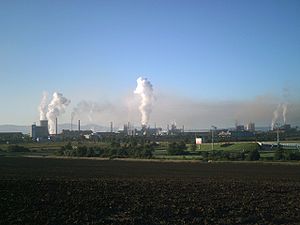Examining Essential Workholding Components: Toggle Clamps And Other Tools
 Workholding is an often overlooked part of machine work. Typically, operators and workers put materials into some type of industrial equipment for stability and hold. However, the right hold is absolutely vital for precision and safety. If materials slip during a machine process, there are more consequences than just an off specification product. Ultimately, when workholding fails, it is not uncommon for machines to become damaged and injuries to occur to operators. This is why it is vital to examine and understand the different types of workholding industrial equipment and their applications.
Workholding is an often overlooked part of machine work. Typically, operators and workers put materials into some type of industrial equipment for stability and hold. However, the right hold is absolutely vital for precision and safety. If materials slip during a machine process, there are more consequences than just an off specification product. Ultimately, when workholding fails, it is not uncommon for machines to become damaged and injuries to occur to operators. This is why it is vital to examine and understand the different types of workholding industrial equipment and their applications.
A Stable Tabletop Holds With Vises
Vises are one of the more common methods for holding materials. They provide a high degree of stability since they are typically mounted directly onto a table or work bench. Vises can achieve a strong hold due to their design. A fixed jaw is set opposite a second jaw which runs along a guide rod that is turned to tighten the vise. Some models also have removable handles so the vise can be tightened beyond hand-tight with a wrench.
Vises come with many accessories and options for flexibility in their usage. Some models come standard with suction cups so they can be temporarily mounted to a bench and then be easily moved to another work area. When working with malleable materials, plastic jaws can be used to prevent marring and denting without compromising hold.
Clamps – The Workhorse Of Workholding Industrial Equipment
When most people think of workholding, they picture clamps. Whether it is a simple spring clamp or a C clamp, this type of industrial equipment has at least a thousand and one uses. Clamps are easy to apply and are great for a quick hold. They are like a third hand at times, making it much easier to set items together with glue or hold down materials as they are cut or otherwise worked. Common examples also include pipe clamps, f clamps, and even flooring clamps.
Clamps are also a type of safety industrial equipment. By holding materials with any type of device, the hands are removed from the work area, helping to prevent cuts and impact injuries. Best working procedures always require workholding devices to be used instead of simply holding materials or bracing them against the worker’s body.
Choosing the right clamp is all about determining capacity. Essentially, capacity is the maximum size of an object that can be safely and securely fastened. The easier way to visualize capacity is to open a C clamp as wide as possible. Technically, capacity is measured from the inside edge of a clamp’s frame to the center of its screw when the tool is wide open.
Powered Devices And working of milling machine Automatic Machining
For heavy duty work, powered workholding industrial equipment is commonly applied. These devices are most likely powered with hydraulic or pneumatic systems. Besides achieving a superior, controlled force, powered components can also be attached to computer and computer numerical control devices for automated production. In many …

 While the economy may still be in recession, there are still many roadway and bridge construction projects being approved. In strong part due to stimulus money, firms are getting awarded many construction jobs through the federal and state governments. To ensure safe work sites for both the benefit of every worker and for compliance to safety guidelines and laws, specifically designed industrial equipment is the key to outfitting workers with the right PPE to do their jobs safely.
While the economy may still be in recession, there are still many roadway and bridge construction projects being approved. In strong part due to stimulus money, firms are getting awarded many construction jobs through the federal and state governments. To ensure safe work sites for both the benefit of every worker and for compliance to safety guidelines and laws, specifically designed industrial equipment is the key to outfitting workers with the right PPE to do their jobs safely. The term, “materials handling” covers a broad spectrum of industrial goods. The most obvious examples of these would be the equipment and containers that are directly involved with the process of moving items. In the industry, however, there are many other products that comprise a complete material handling system.
The term, “materials handling” covers a broad spectrum of industrial goods. The most obvious examples of these would be the equipment and containers that are directly involved with the process of moving items. In the industry, however, there are many other products that comprise a complete material handling system. Do you find that you have way too many cleaning supplies hanging around? And you don’t know what you need and what you don’t? And then you can’t
Do you find that you have way too many cleaning supplies hanging around? And you don’t know what you need and what you don’t? And then you can’t  Part I of this series covered safety attire that should be worn or available for use in a woodshop. In Part II, we cover some essential safety precautions to help prevent injury or provide first aid should an accident occur in the woodshop.
Part I of this series covered safety attire that should be worn or available for use in a woodshop. In Part II, we cover some essential safety precautions to help prevent injury or provide first aid should an accident occur in the woodshop. Hazards exist on every job site. In fact, OSHA recorded over 3.5 million injuries in 2008 alone. Businesses need to incorporate the right industrial apparel in conjunction with safe working practices in order to have an injury-free work environment. Industrial equipment and clothing are designed to mitigate hazards, prevent accidents, and reduce the severity of any injuries that may occur. Having a personal protective equipment program in place is essential for every company.
Hazards exist on every job site. In fact, OSHA recorded over 3.5 million injuries in 2008 alone. Businesses need to incorporate the right industrial apparel in conjunction with safe working practices in order to have an injury-free work environment. Industrial equipment and clothing are designed to mitigate hazards, prevent accidents, and reduce the severity of any injuries that may occur. Having a personal protective equipment program in place is essential for every company. There are numerous potential hazards in the woodturning workshop. Extremely sharp cutting tools and high speed machinery form a potentially lethal combination. When the novice wood turner is busy buying tools and equipment it is easy to lose sight of health and safety issues. You would do well to remember that your health is the one thing that you cannot put a price on.
There are numerous potential hazards in the woodturning workshop. Extremely sharp cutting tools and high speed machinery form a potentially lethal combination. When the novice wood turner is busy buying tools and equipment it is easy to lose sight of health and safety issues. You would do well to remember that your health is the one thing that you cannot put a price on. Hazards exist on every job site. In fact, OSHA recorded over 3.5 million injuries in 2008 alone. Businesses need to incorporate the right industrial apparel in conjunction with safe working practices in order to have an injury-free work environment. Industrial equipment and clothing are designed to mitigate hazards, prevent accidents, and reduce the severity of any injuries that may occur. Having a personal protective equipment program in place is essential for every company.
Hazards exist on every job site. In fact, OSHA recorded over 3.5 million injuries in 2008 alone. Businesses need to incorporate the right industrial apparel in conjunction with safe working practices in order to have an injury-free work environment. Industrial equipment and clothing are designed to mitigate hazards, prevent accidents, and reduce the severity of any injuries that may occur. Having a personal protective equipment program in place is essential for every company.